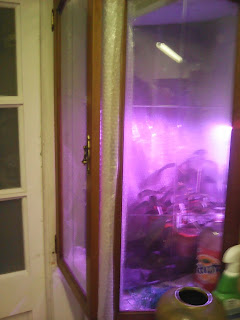As the season comes to an end I am always looking for ways to preserve my excess peppers. I have already mad a couple of different sauces and salsas which have worked well. As I cut back a lot of pepper plants today I had a bit of a glut.
Pepper glut
The first method I chose to try was pickling. I had a lot of green unripe and purple chunky pods which would be well suited to pickling. I cut these into rings and placed in a colander so I could wash away the worst of the seeds. I then put these in a large jar. I also added a few yellow and red peppers for a bit bit of contrasting colour. I then heated in a saucepan equal parts water and vinegar, I added a generous amount of salt and black pepper, then brought this too the boil, before turning down to a simmer. After five minutes I turned this off and poured it over the peppers. I filled the jar to the brim and place a rolled up ball of cling film on top. this was to hold the peppers under the brine/vinegar mixture, once the jar is then sealed shut.
Pickled peppers
Next I decide to try make some chilli jam. for this I cheated. I used some shop bought apricot jam as a base. In a blender, I added three nectarines and some big sun Habanero pepper pods. I then transferred this too a saucepan, added more sugar and brought to the boil. I then turned this down to a simmer until it reduced to the desired consistency. I filled up 2 small jars with this jam and they have both set nicely. this jam is ready to use strait away and is nice with meat and cheese.
Finished jam
Of the peppers I had left, all the thin walled (thus easy to dry) varieties were threaded on to a ristra. these varieties will dry in the kitchen window and will be made into powder later.
Ristra
The remaining peppers were dried using my dehydrator. this is useful when drying thick walled peppers that otherwise might mold if left to dry naturally. This is the first time I have dried green peppers but as i had lots I thought I would give it a go. I also added some of my tomatoes to see if they would dry.
Dehydrator
There are many other ways to preserve peppers and I will try others as I harvest the last of my pepper plants but After all that lot it will be while before I feel like venturing back into the kitchen.




















































